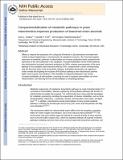| dc.contributor.author | Stephanopoulos, Gregory | |
| dc.contributor.author | Avalos, Jose L. | |
| dc.contributor.author | Fink, Gerald R. | |
| dc.date.accessioned | 2014-01-27T19:03:29Z | |
| dc.date.available | 2014-01-27T19:03:29Z | |
| dc.date.issued | 2013-02 | |
| dc.date.submitted | 2012-11 | |
| dc.identifier.issn | 1087-0156 | |
| dc.identifier.issn | 1546-1696 | |
| dc.identifier.uri | http://hdl.handle.net/1721.1/84595 | |
| dc.description.abstract | Efforts to improve the production of a compound of interest in Saccharomyces cerevisiae have mainly involved engineering or overexpression of cytoplasmic enzymes. We show that targeting metabolic pathways to mitochondria can increase production compared with overexpression of the enzymes involved in the same pathways in the cytoplasm. Compartmentalization of the Ehrlich pathway into mitochondria increased isobutanol production by 260%, whereas overexpression of the same pathway in the cytoplasm only improved yields by 10%, compared with a strain overproducing enzymes involved in only the first three steps of the biosynthetic pathway. Subcellular fractionation of engineered strains revealed that targeting the enzymes of the Ehrlich pathway to the mitochondria achieves greater local enzyme concentrations. Other benefits of compartmentalization may include increased availability of intermediates, removing the need to transport intermediates out of the mitochondrion and reducing the loss of intermediates to competing pathways. | en_US |
| dc.description.sponsorship | National Institutes of Health (U.S.). Ruth L. Kirschstein National Research Service Award (1F32GM098022-01A1) | en_US |
| dc.description.sponsorship | National Institutes of Health (U.S.) (Grant GM040266) | en_US |
| dc.description.sponsorship | Shell Global Solutions (US) | en_US |
| dc.language.iso | en_US | |
| dc.publisher | Nature Publishing Group | en_US |
| dc.relation.isversionof | http://dx.doi.org/10.1038/nbt.2509 | en_US |
| dc.rights | Creative Commons Attribution-Noncommercial-Share Alike 3.0 | en_US |
| dc.rights.uri | http://creativecommons.org/licenses/by-nc-sa/3.0/ | en_US |
| dc.source | PMC | en_US |
| dc.title | Compartmentalization of metabolic pathways in yeast mitochondria improves the production of branched-chain alcohols | en_US |
| dc.type | Article | en_US |
| dc.identifier.citation | Avalos, José L, Gerald R Fink, and Gregory Stephanopoulos. “Compartmentalization of metabolic pathways in yeast mitochondria improves the production of branched-chain alcohols.” Nature Biotechnology 31, no. 4 (February 17, 2013): 335-341. | en_US |
| dc.contributor.department | Massachusetts Institute of Technology. Department of Chemical Engineering | en_US |
| dc.contributor.department | Whitehead Institute for Biomedical Research | en_US |
| dc.contributor.mitauthor | Avalos, Jose L. | en_US |
| dc.contributor.mitauthor | Stephanopoulos, Gregory | en_US |
| dc.contributor.mitauthor | Fink, Gerald R. | en_US |
| dc.relation.journal | Nature Biotechnology | en_US |
| dc.eprint.version | Author's final manuscript | en_US |
| dc.type.uri | http://purl.org/eprint/type/JournalArticle | en_US |
| eprint.status | http://purl.org/eprint/status/PeerReviewed | en_US |
| dspace.orderedauthors | Avalos, José L; Fink, Gerald R; Stephanopoulos, Gregory | en_US |
| dc.identifier.orcid | https://orcid.org/0000-0003-3704-2899 | |
| dc.identifier.orcid | https://orcid.org/0000-0001-6909-4568 | |
| mit.license | OPEN_ACCESS_POLICY | en_US |
| mit.metadata.status | Complete | |
